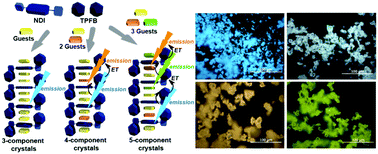Flexible-color tuning and white-light emission in three-, four-, and five-component host/guest co-crystals by charge-transfer emissions as well as effective energy transfers†
Abstract
Three-, four-, and five-component host/guest crystals with multi-color and white light emission is described. Our strategy is based on the confinement of aromatic donor guests in supramolecular acceptor hosts. The supramolecular acceptor hosts (NDI–TPFB) were composed of N,N′-dipyrid-3-yl-1,4,5,8-naphthalenediimide (NDI) with two tris(pentafluorophenyl)borane (TPFB) linked by boron–nitrogen dative bonds as Lewis acid–base pairs, which spontaneously formed upon mixing the components. In the first part, a set of three-component crystals with 14 different aromatic guests were characterized to elucidate the structure–property relationships. In the latter part, a series of 17 types of four- and five-component crystals were formed with the use of binary or ternary guest inclusion systems, and their structural and photophysical properties were investigated. Among them, 14 types of crystals were formed effectively without destroying the crystal structure, as determined by X-ray diffraction and fluorescence microscopy. Notably, flexible color tuning, including white light emission, was realized by tuning the guest ratio and the combinations. Various intermolecular interactions such as C–H⋯F interactions, π–π stacking, charge-transfer interactions, and inclusion phenomena were important for forming the crystals. This approach that yields a rational solution of multicomponent crystals could be potentially useful for obtaining novel photofunctional solid-state systems.



 Please wait while we load your content...
Please wait while we load your content...